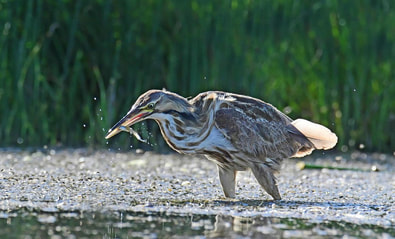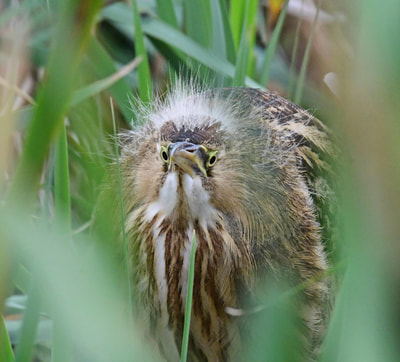 The first time I heard the distinctive pump-er-lunk call of an American Bittern was while canoeing many decades ago on a beautiful little lake west of Rimbey. Lucky for me, my canoeing partner, Fred, was an expert naturalist. He quietly regaled me with bittern stories and information while we scoured the shoreline cattails, eager to catch a glimpse of this elusive heron. Eventually, we found it—a streaked brown bird standing motionless in the cattails, its body stretched up and its beak pointed skyward. Its bright yellow eyes, wide and sparkling, glared directly at us. Standing as still as a marble statue, we realized that the bird had every confidence that it was invisible to us. In the years since that enchanting encounter, I’ve been on the lookout for bitterns. However, except for a quick glance and hasty photo of one standing in a ditch two years ago, I’ve not seen another one. Last summer, I finally lucked out. First, we encountered a young bittern at Elk Island National Park in early July. It remained obscured by cattails, but I was able to snap a few habitat photos. Then, a few weeks later, while kayaking with a friend in the beautiful bay of Rochon Sands at Buffalo Lake, we encountered two bitterns. For about an hour, we watched these birds patrol the shallows right in front of us. It was truly a ringside seat! They would occasionally stretch their necks up as if perceiving some threat, but mostly they ignored us, concentrating their attention on the abundant schools of shoreline minnows. They would alternate between walking slowly and standing motionless, all the while staring intently into the water. Then zap, they would plunge their heads into the lake and come up with a minnow. After a short but hopeless struggle, the fish would be gulped down. American Bitterns, like all herons, are found around wetlands. Although they are fairly common in Central Alberta, they are seldom encountered (as I can attest) because they spend most of their time well concealed in shoreline cattails and bulrushes. They are more often heard than seen, as they emit a deep booming pump-er-lunk call. This call is so distinctive that has earned them the nickname “thunder pumper.” Some of their more obvious physical adaptations include cryptic coloration, long legs and massive feet. They also have incredible eyes. Bright yellow in colour, their eyes have the unique ability to focus downward, an attribute which enables them to stare down into the water to look for fish, frogs and other prey. These moveable eyeballs also allow them to track activity that is taking place in front of them (such as intruding canoeists or kayakers), even when their neck is stretched upward. Although this trait gives them a cross-eyed and startled appearance, it serves them well while foraging and avoiding predators. To learn more about American Bitterns and hear their distinctive call, check out The Cornell Lab of Ornithology. |
AuthorMyrna Pearman Archives
August 2022
|
All photos and published works on this website are copyright Myrna Pearman unless otherwise noted.
Re-posting these images or publishing is not permitted without Myrna's written consent.
Copyright Myrna Pearman Publishing 2024- Site design and maintenance by Carolyn Sandstrom
Re-posting these images or publishing is not permitted without Myrna's written consent.
Copyright Myrna Pearman Publishing 2024- Site design and maintenance by Carolyn Sandstrom








 RSS Feed
RSS Feed



17/9/2017
1 Comment